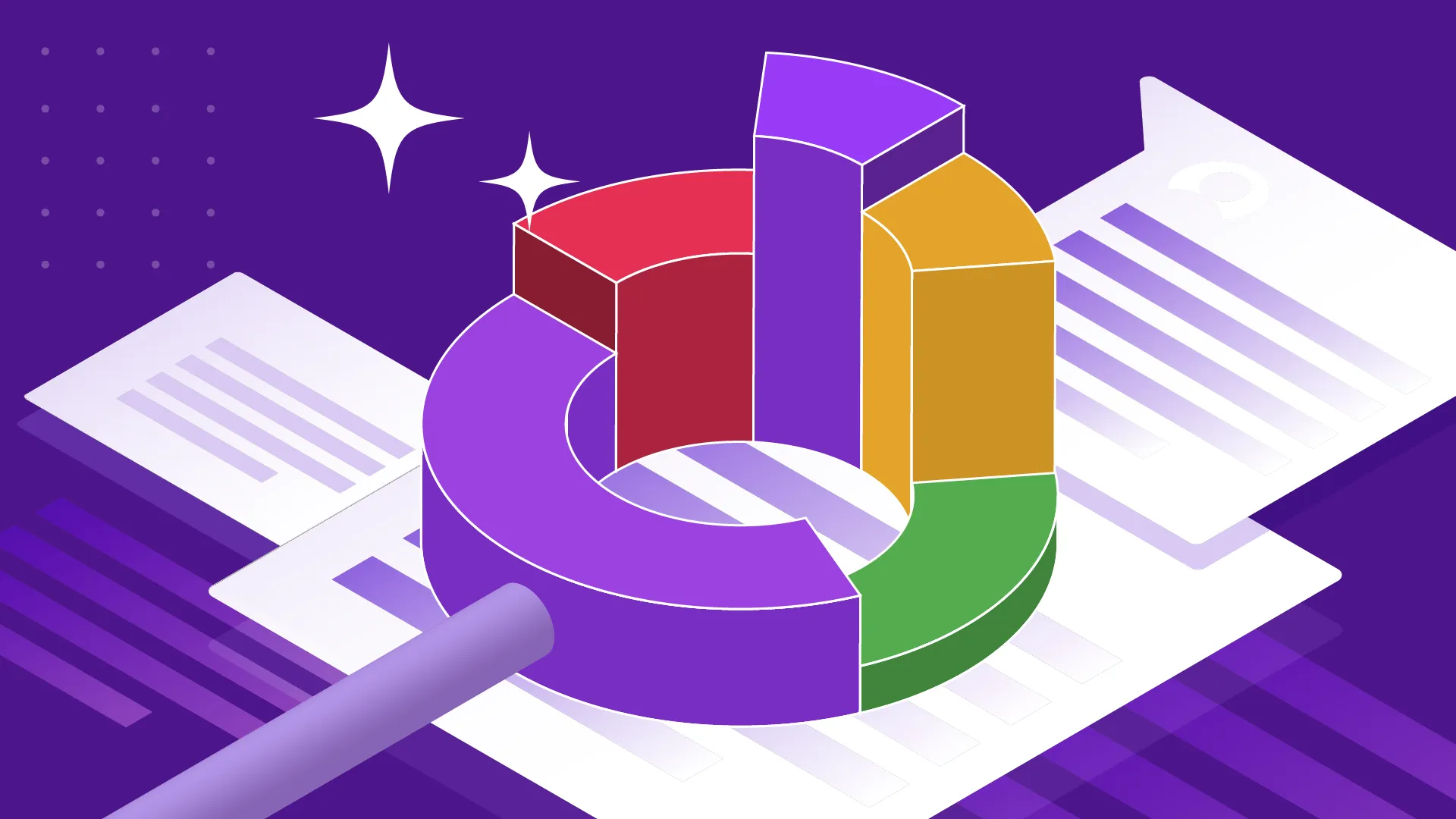
Learn how text analytics transforms unstructured data into actionable insights for enhanced customer experience.

Is your business swimming in feedback from customers? Whether it’s reviews, emails, or social media posts, does it feel like you’re barely scratching the surface of what customers are truly saying?
We get it—sifting through all that information can feel overwhelming. But here's the thing: hidden in that feedback are valuable insights into what your customers love, what frustrates them, and where you can improve.
Without the right tools, these golden nuggets of information often slip through the cracks, leaving opportunities untapped. That’s where text analytics comes in. This powerful tool transforms unstructured feedback into clear, actionable insights. It helps you:
With more businesses embracing tools like natural language processing (NLP) to analyze customer sentiment, staying ahead means rethinking how you approach feedback. In fact, over a third of companies plan to integrate NLP into their strategies by 2025.
Let’s explore how text analytics works, why it’s a game-changer, and how you can use it to turn feedback into better decisions. Here’s what we’ll cover:
Let’s dive in and discover the transformative power of text analytics for your business!
Imagine having a tool that transforms the endless flow of customer reviews, emails, and social media comments into actionable insights. That’s exactly what text analytics does. It takes unstructured feedback—free-form text that doesn’t fit neatly into rows and columns—and makes it clear, meaningful, and ready to act on.
When we say unstructured data, we’re talking about the kind of information that makes up 80% of enterprise data. Without text analytics, you’d have to manually comb through this mountain of feedback. Frustrating, right? That’s where text analytics steps in to save the day.
Here’s how it helps:
Think of it as having a supercharged assistant that helps you move from feedback to action without the guesswork, making customer review analysis a breeze.
Ready to learn more about how this can work for your business? Find out more about what text analytics is and what it can do for you.
At the heart of text analytics lies NLP, a cutting-edge technology that helps computers understand human language. It analyzes elements like parts of speech, syntax, and context.
Let’s put it into perspective. Imagine spending hours sorting through customer reviews, grouping them into categories like “product quality” or “shipping issues,” and figuring out whether the feedback is positive or negative. Exhausting, right?
Now, imagine a tool that does all of this for you in minutes. That’s NLP in action, helping you extract information quickly and efficiently, making your job easier and more effective.
NLP isn’t just fast; it’s constantly improving. Advanced tools like GPT-4 are 30% more effective than earlier models, while multilingual systems like mBERT make analyzing feedback from global audiences a breeze. Whether you need to spot trends or track customer sentiment over time, text analytics adapts to meet your needs.
Want to dig deeper into the magic behind this technology? Learn how text analytics works.
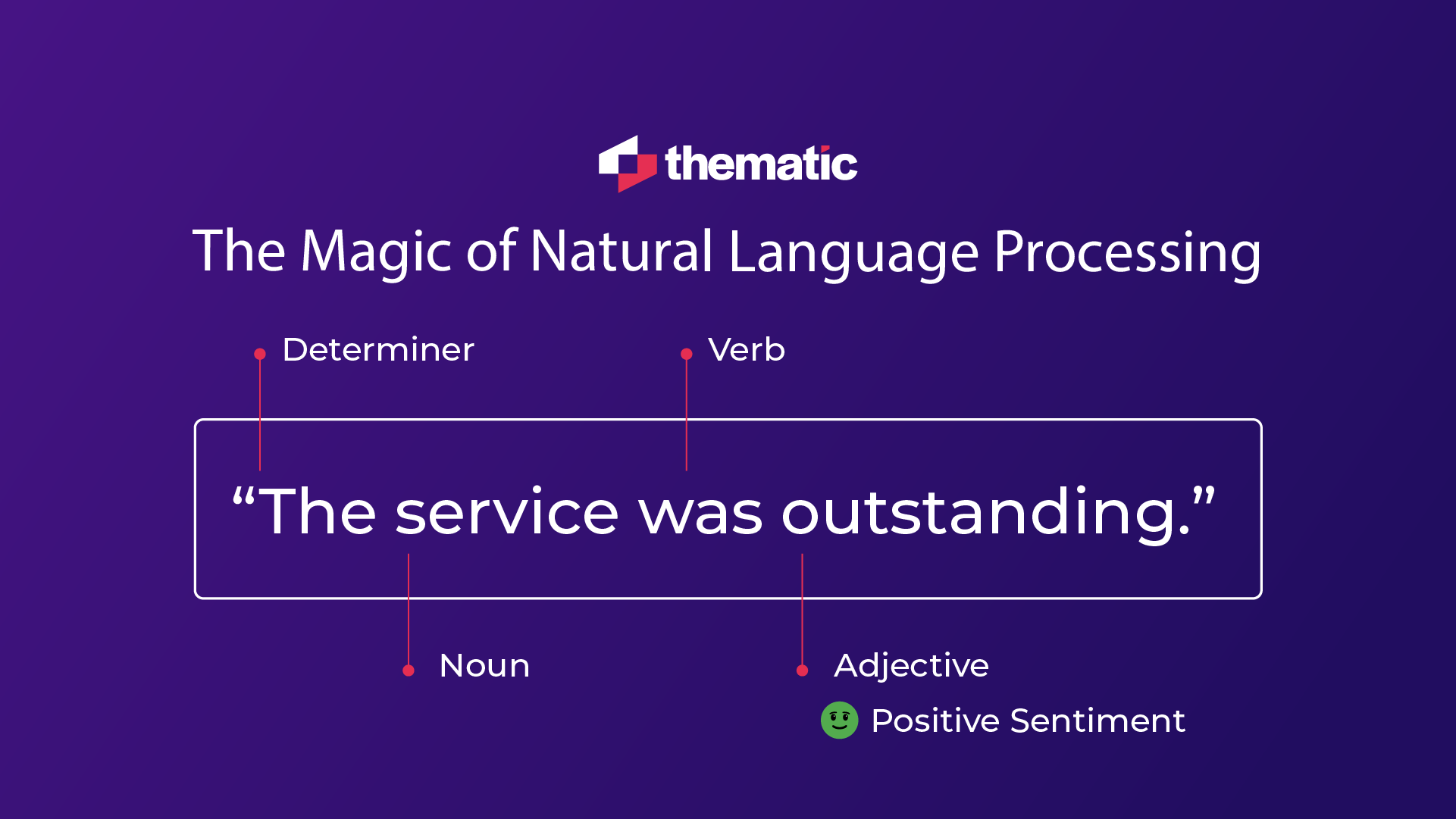
Text analytics delivers real results for businesses like yours every day.
But it doesn’t stop at businesses. Text analytics is already woven into everyday life—your email’s spam filter and your phone’s predictive text are both powered by NLP.
Your inbox is flooded with emails, your reviews pile up by the minute, and your social media notifications? Let’s not even go there. Amidst this flood of customer feedback lies a treasure trove of insights—but only if you can make sense of it.
This is where text analytics shines. It transforms raw, messy feedback into actionable insights, helping you uncover opportunities that might otherwise slip through the cracks.
Think of it as a pair of glasses that lets you see what your customers really want, love, or struggle with—making it a powerful ally in your business intelligence efforts.
Here’s how text analytics changes the game:
But that’s just the start. Let’s dig into why text analytics matters.
Imagine this: Starbucks has just launched a new drink. The buzz is everywhere—tweets, posts, reviews. But how do they know if people love it? Easy: they use text analytics to track what their customers are saying in real time. By spotting patterns, they tweak their marketing strategy on the fly and keep the hits rolling.
This ability to act fast isn’t just a perk—it’s the future. The big data and analytics market is set to skyrocket from $274 billion in 2023 to $693 billion by 2032. That’s a lot of businesses turning data into action.
So, what’s the secret sauce? Understanding the voice of the customer. It’s the key to meeting customer needs, staying ahead of the competition, and building relationships that last.
Here’s a hard truth: over 50% of customers leave after a single bad experience. That number jumps to 73% after multiple issues. The stakes couldn’t be higher. But with text analytics, you can catch problems before they send your customers running.
Take Vodafone New Zealand, for instance. They used Thematic to tackle their Touchpoint Net Promoter Score (tNPS) across customer-facing teams. Here’s what happened:
Text analytics helps you not just keep customers but wow them.
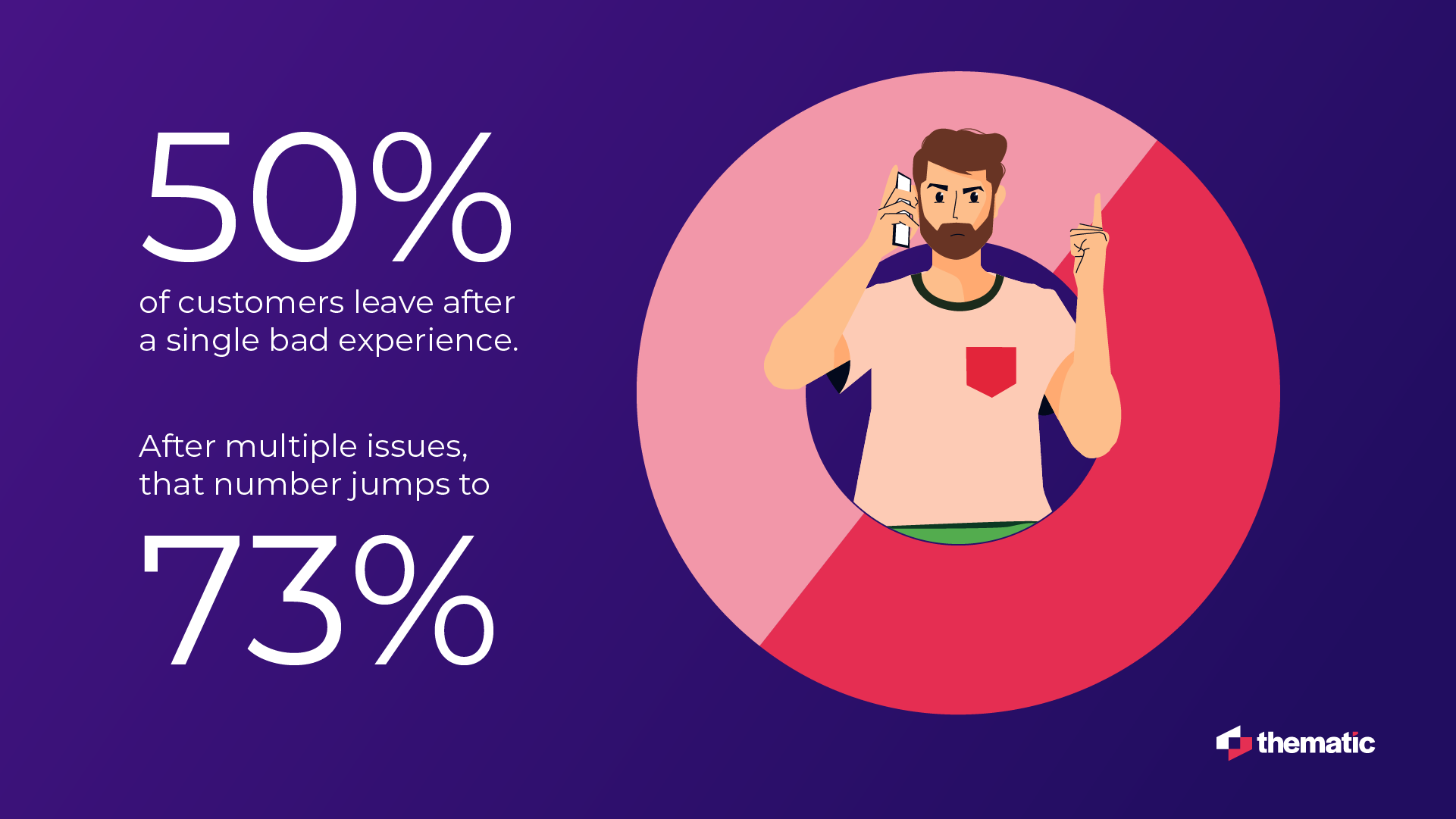
Innovation doesn’t start with guesses—it starts with insights. And when you’re collecting data from all corners—emails, surveys, tweets—it’s easy to get overwhelmed. But text analytics? It turns that noise into opportunities.
Take MMGY, a travel and hospitality marketing agency working with a global cruise line. They faced a mountain of feedback: 8,000 customer comments every month, paired with RFID transaction data. It was too much to handle manually.
Enter Thematic. By combining text analytics with transactional data, MMGY:
With these insights, MMGY helped their client make smarter decisions and improve services—turning passenger feedback into better experiences.
Want more details? Explore the benefits of text analytics further.
Text analytics uses various approaches. It's like having a detective for your feedback—uncovering clues, spotting patterns, and helping you solve customer mysteries. These techniques do the heavy lifting, turning raw comments into powerful insights.
Here’s a breakdown of how text analytics works:
Before diving into analysis, the text needs a good cleanup. Think of it like sorting laundry before washing—it’s not glamorous but essential.
Preprocessing steps prepare text documents for deeper analysis, ensuring that raw data is organized and ready to deliver insights.
Here’s how it happens:
The magic doesn’t stop there. Advanced methods, like real-time processing, can instantly pick out meaningful words in feedback. Picture a tool that scans reviews as they arrive, flagging trends like “late delivery” or “amazing service” on the fly.
Ever tried organizing a cluttered closet? That’s what text classification does for your feedback—it sorts everything into categories like “shipping issues” or “product quality.” Suddenly, chaos becomes order.
Early rule-based systems relied on predefined patterns to classify text, such as specific category keywords. While effective for simple tasks, they struggled with flexibility and nuance.
Today’s models, like Support Vector Machines (SVM), make this process faster and smarter, boasting up to 84.58% accuracy. And while machines are great, some situations still call for a human touch—because, let’s face it, we’re pretty good at reading between the lines.
A real-world example? Smith & Smith, a vehicle glass repair company in New Zealand, used Thematic to categorize customer themes and connect them to Net Promoter Scores (NPS). The result? Time was saved, and improvements were targeted precisely where they were needed.
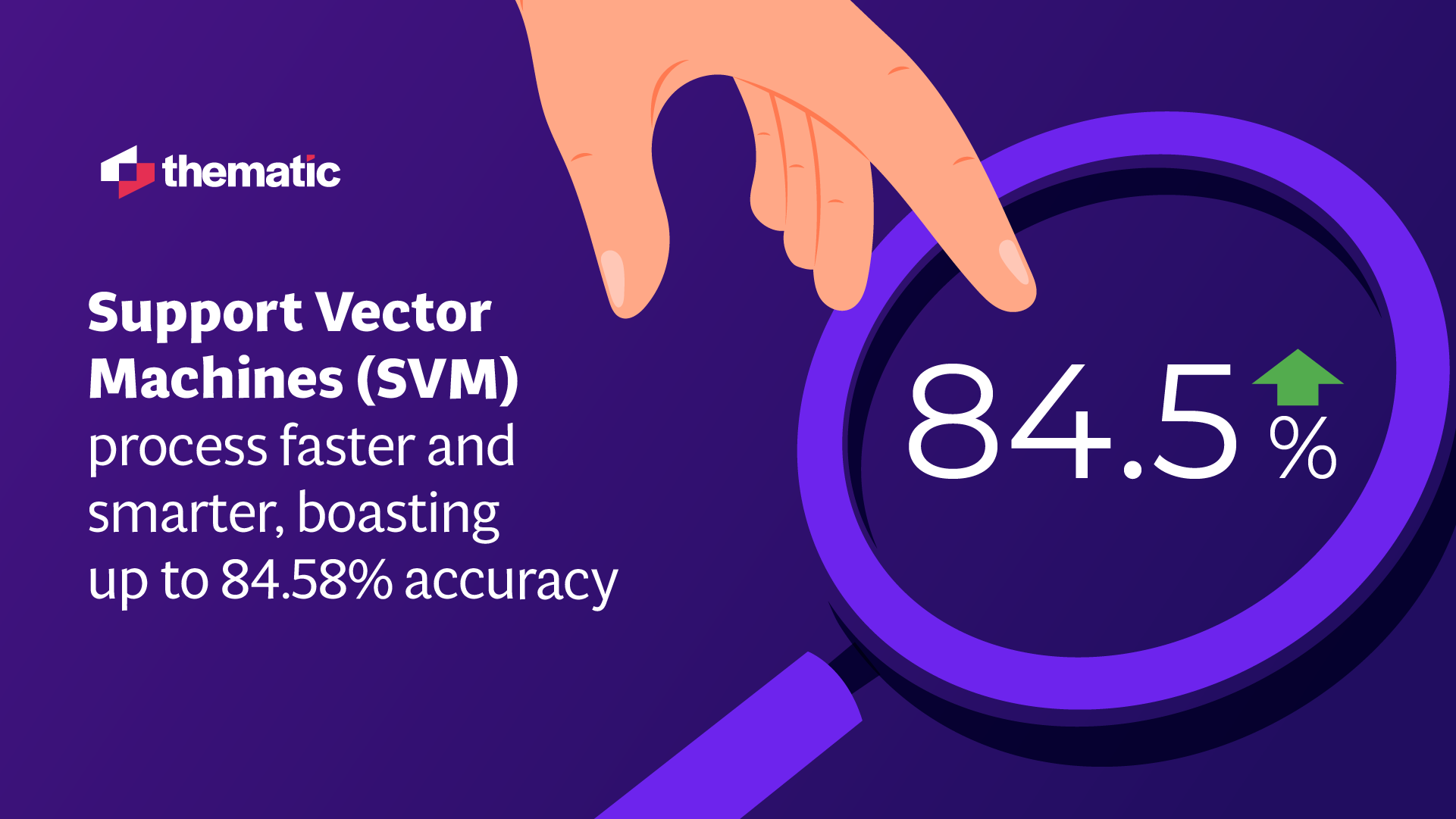
If text preprocessing and classification are the foundation, topic modeling is the spotlight—it highlights the recurring themes hiding in your data.
Using tools like Latent Dirichlet Allocation (LDA), topic modeling finds the patterns that matter. For example, Levels, a health and wellness company, analyzed over 2,700 survey responses with Thematic. They uncovered specific product issues, giving their team laser-focused priorities to improve the customer experience.
Topic modeling turns overwhelming data into a clear picture of what your customers are really talking about.
Text analytics doesn’t just stop at “what” customers say; it dives into “how” they feel about it. Sentiment analysis is your tool for understanding emotions—joy, frustration, or everything in between.
Here’s the scoop:
But challenges aside, tools like Thematic have mastered the art of uncovering valuable insights. Take Melodics, a music-learning platform. They analyzed every piece of customer feedback—ensuring no comment went unnoticed—and used those insights to sharpen their products.
And sentiment analysis isn’t just about warm fuzzies. It’s practical, too. Support teams use it to prioritize urgent tickets, ensuring that critical issues don’t slip through the cracks.
Text analytics tools use advanced technologies to reveal patterns, uncover customer emotions, and provide the clarity you need to make smarter decisions.
Let’s dive into the tools, technologies, and how they help businesses thrive. Understanding this will help you choose text analytics tools that fits your business needs best.
Text analytics software comes in many flavors, but some stand out for their ability to simplify the complex:
The history of text analytics is robust: modern technology has made this once dauting task happen at lightning speed.
Modern text analytics tools owe much of their magic to cutting-edge technologies like Large Language Models (LLMs) and deep learning algorithms. These tools can:
Beyond that, edge computing enables faster data processing by analyzing information close to its source (think in-store kiosks). And with serverless computing, tools can handle enormous amounts of data without requiring heavy-duty hardware. It’s like getting high performance without the high costs.
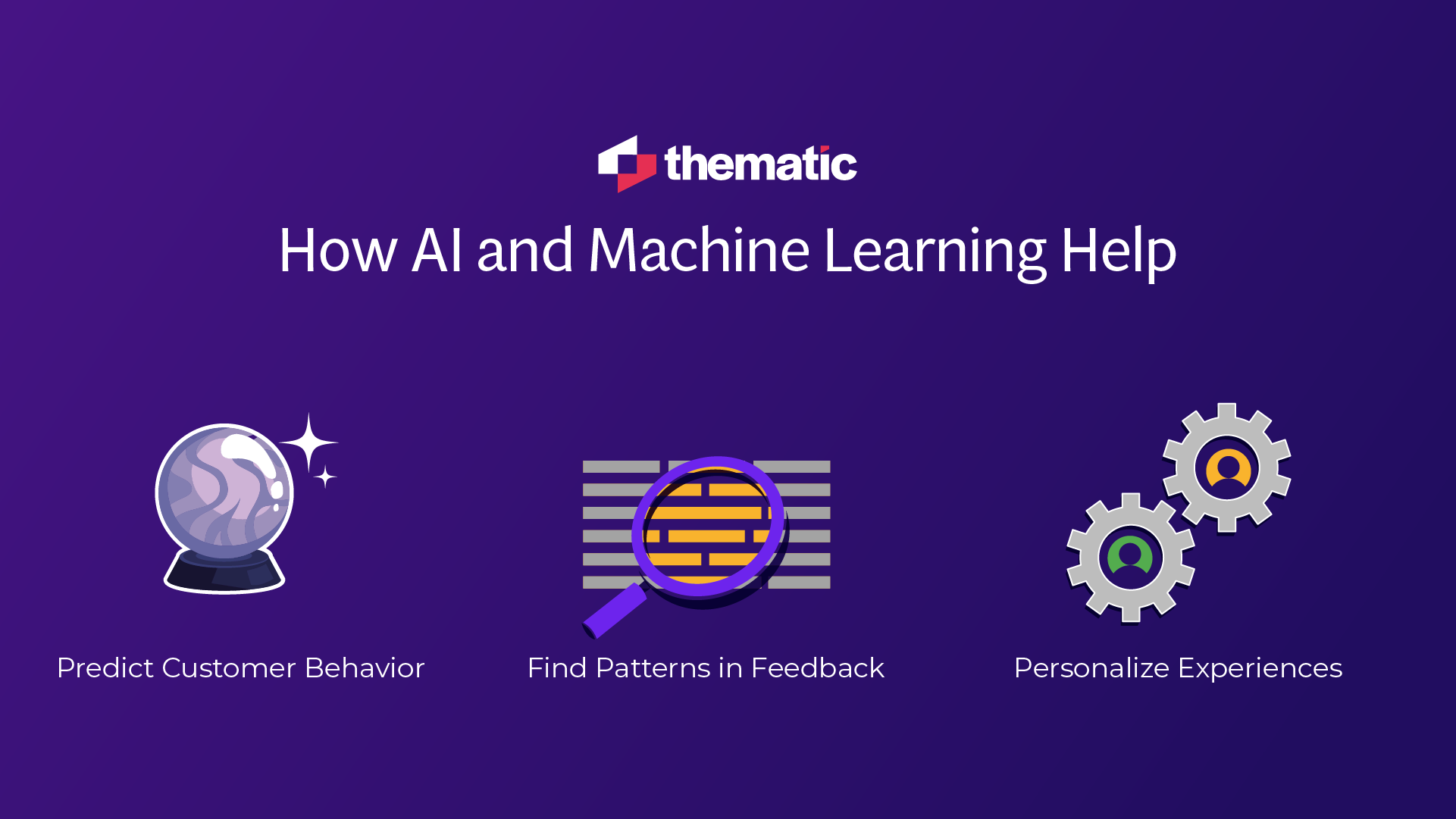
From resolving customer pain points to managing large-scale operations, text analytics tools are transforming industries. Here are some success stories:
These examples prove that whether you’re a global corporation or a local team, the right tools can make all the difference.
Data storage is just as important as data analysis. Most businesses today rely on cloud-based systems for their flexibility and cost-effectiveness. However, some opt for on-premises systems when they need more control—though these require additional resources to maintain.
Modern innovations like data lakehouses take storage to the next level. By combining structured data (like numbers in spreadsheets) and unstructured data (like customer comments), they make it easier to analyze the big picture and uncover meaningful trends.
Think text analytics is just about sorting feedback? Think again. It’s a powerhouse that helps businesses solve problems, delight customers, and make smarter moves—all with a deeper understanding of what people are really saying.
From real-time insights to industry-specific solutions, the possibilities are endless.
Let's look at different text analytics applications.
Imagine catching customer issues as they happen—before they snowball into complaints. With text analytics, you don’t just react; you proactively improve. By analyzing feedback in real time, businesses can track metrics like CSAT and NPS to stay ahead of the game.
Take DoorDash, for example. They used Thematic to zero in on merchant frustrations like slow updates and repetitive tasks. Armed with these insights, they slashed tool load times from 11 seconds to under 3 seconds—and wowed their customers in the process. That’s the power of acting on real-time insights.
Text analytics isn’t a one-trick pony. It’s transforming operations across the board, tackling challenges like:
No matter your business challenge, text analytics helps you tackle it head-on.
Text analytics has a knack for adapting to any industry. Here’s how it shines:
Real examples? Hilti uncovered recurring service issues in customer notes, while FSU analyzed over 100,000 IT tickets to identify patterns that improved their processes. No guesswork—just results.
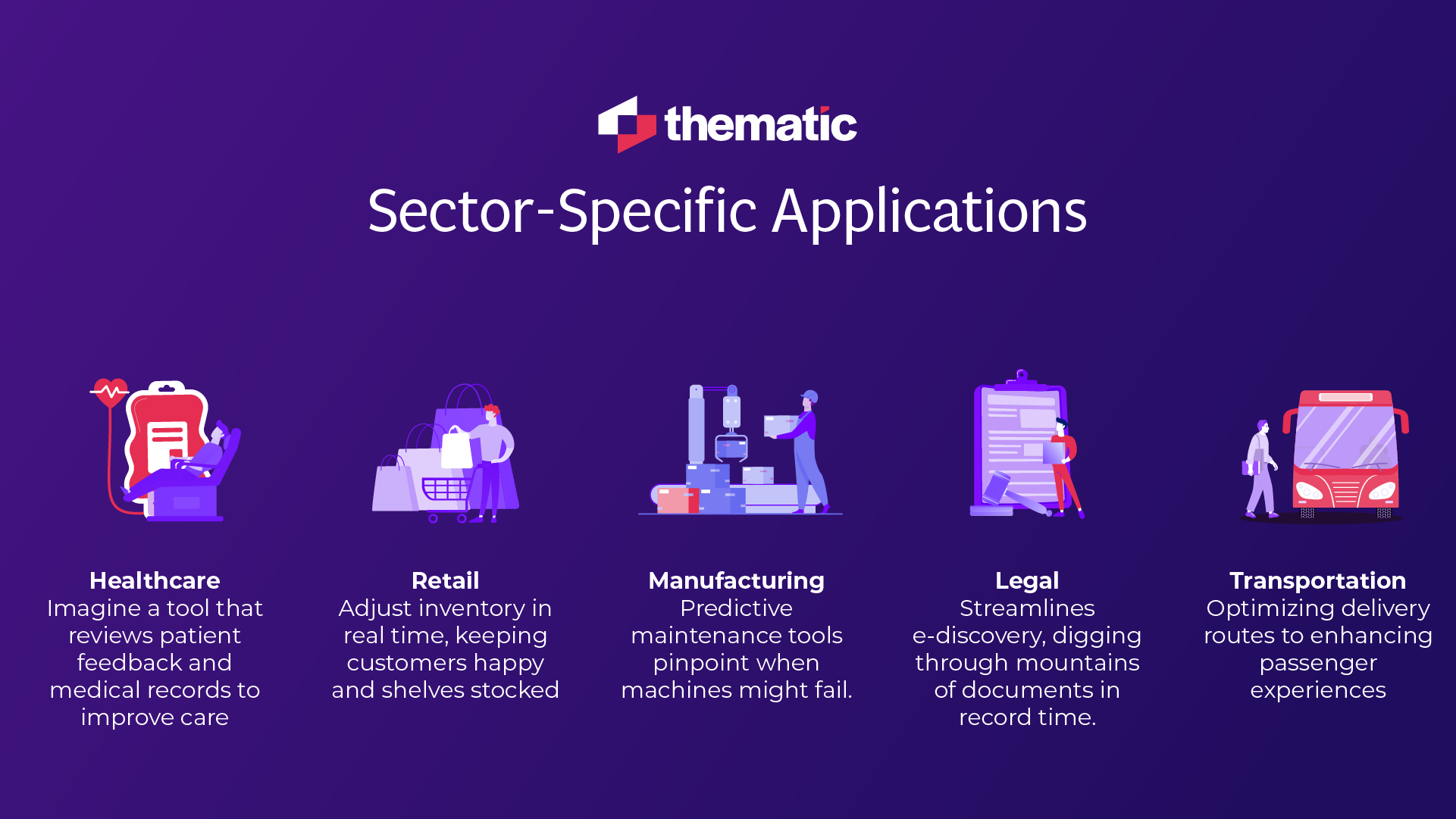
Ever wonder what customers really feel about your product? Like I said earlier, sentiment analysis doesn’t just tell you—it shows you the emotions driving their words. Whether it’s joy, frustration, or just indifference, this tool dives deep.
Here’s how businesses use it:
Traveloka nailed it by using sentiment analysis to understand why customers loved their discounts but struggled with app usability. The result? A refined app and better promotions. That’s how you turn feedback into action.
Learn more about how text analytics and sentiment analysis work together.
Dashboards are like your text analytics command center. They translate all that data into easy-to-digest visuals that highlight exactly what you need to know. Think:
For example, Hilti used dashboards to prioritize service fixes, while FSU improved response times by tracking IT issues visually. It’s insight without the overload.
Text analytics has changed the game in understanding feedback, but it’s no magic wand. As businesses grapple with ever-growing data and emerging tech, challenges loom large—but so do opportunities.
Here’s a closer look at the roadblocks and the breakthroughs ahead.
Even the smartest tools can struggle when the stakes are this high. These are the big hurdles standing in the way of seamless text analytics.
Data is everywhere—44 zettabytes and counting—but most of it is unstructured chaos. Imagine trying to organize an entire ocean, and you’ll get the picture. With only 2% of data saved for future use in 2020, businesses face a steep climb in managing storage and retrieval.
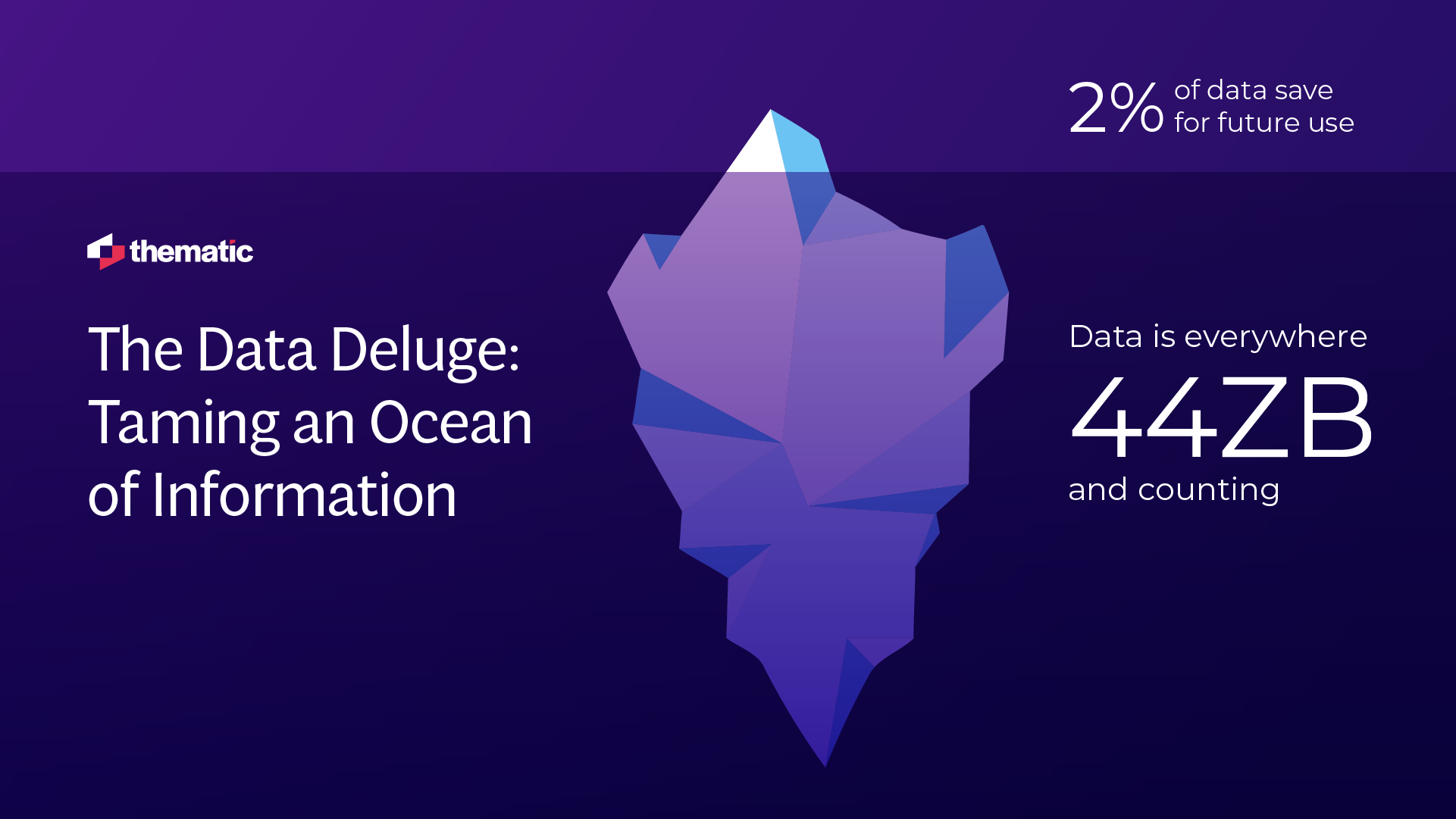
AI isn’t born unbiased. It learns from its training data, which can embed societal inequities. Take the case of a healthcare algorithm that reduced Black patients’ access to additional care from 46.5% to 17.7%.
Bias enters through outdated data, narrow objectives, and homogenous teams, creating ripple effects that can’t be ignored.
Advanced tools are game-changers—but they’re not cheap. Add a shortage of skilled experts, and small and mid-sized businesses are often left out of the race. The result? A world where only the big players can afford to play.
With data privacy laws tightening and consumers growing more cautious, businesses face mounting pressure to balance innovation with transparency. No easy task.
The best text analytics solutions don’t just solve problems—they open doors. Here’s how companies are turning challenges into wins:
Text analytics works best when embedded in decision-making teams, not buried in IT. Take Vodafone, which moved from manual feedback analysis to automated systems using Thematic. The result? We said it earlier: Faster, bias-free insights that spark action.
Why choose between control and scalability? Hybrid models combine on-premises systems with cloud flexibility, giving businesses the best of both worlds. As cloud adoption grows, this approach is becoming a no-brainer.
Tools like AI Fairness 360 are helping businesses fight bias by diversifying training datasets and refining algorithms. IBM’s success in improving facial recognition through inclusive data shows the way forward—ethical AI isn’t just good for society; it’s good for business.
Text analytics is on the brink of a revolution, with cutting-edge trends poised to redefine how businesses extract insights from feedback. As machine learning and AI evolve, the possibilities for innovation are boundless.
Here’s what’s on the horizon:
What if your tools could predict what your customers want—even before they know it? Machine learning algorithms are making that a reality. By combining customer feedback with data on behavior and purchases, businesses can spot patterns that keep customers coming back.
From predicting shipping delays to recommending popular features, machine learning will make personalization faster and easier than ever before.
Entity recognition is about to get more advanced. It won’t just recognize names or places—it will also link them to specific situations.
For example, if customers complain about “delivery,” the system can connect it to issues like “holiday rush delays” or “carrier problems.” This helps businesses understand not just what the problem is but where to act.
What’s the difference between “great support” and “needs support”? Part of speech tagging will help businesses figure it out. By identifying whether a word is used positively or negatively, businesses can get sharper insights into how customers feel.
Paired with sentiment analysis, this tool will help companies respond faster and make smarter decisions.
No more wasting hours on sorting through open-ended feedback. Future AI tools will make qualitative data analysis quick and simple. They’ll turn unstructured comments into clear insights displayed in easy-to-read dashboards.
This will let teams act on customer feedback without spending endless time sorting through it.
Imagine a tool that doesn’t just flag problems—it tells you exactly how to fix them. Real-time decision engines will do just that.
If customers report app crashes, these tools will pinpoint the issue and recommend solutions—often before customers even notice the problem.
As businesses expand globally, understanding feedback in different languages is key. New multilingual analytics tools will keep the meaning and tone of customer feedback clear, no matter the language or region.
This means businesses can deliver a great experience anywhere in the world.
AI isn’t just about analyzing feedback—it’s about acting on it. Generative AI will go a step further, creating action plans and strategies based on customer data. For example, generative AI could provide a step-by-step solution to fix an issue.
Thematic is already pioneering this future with Generative AI in text analytics.
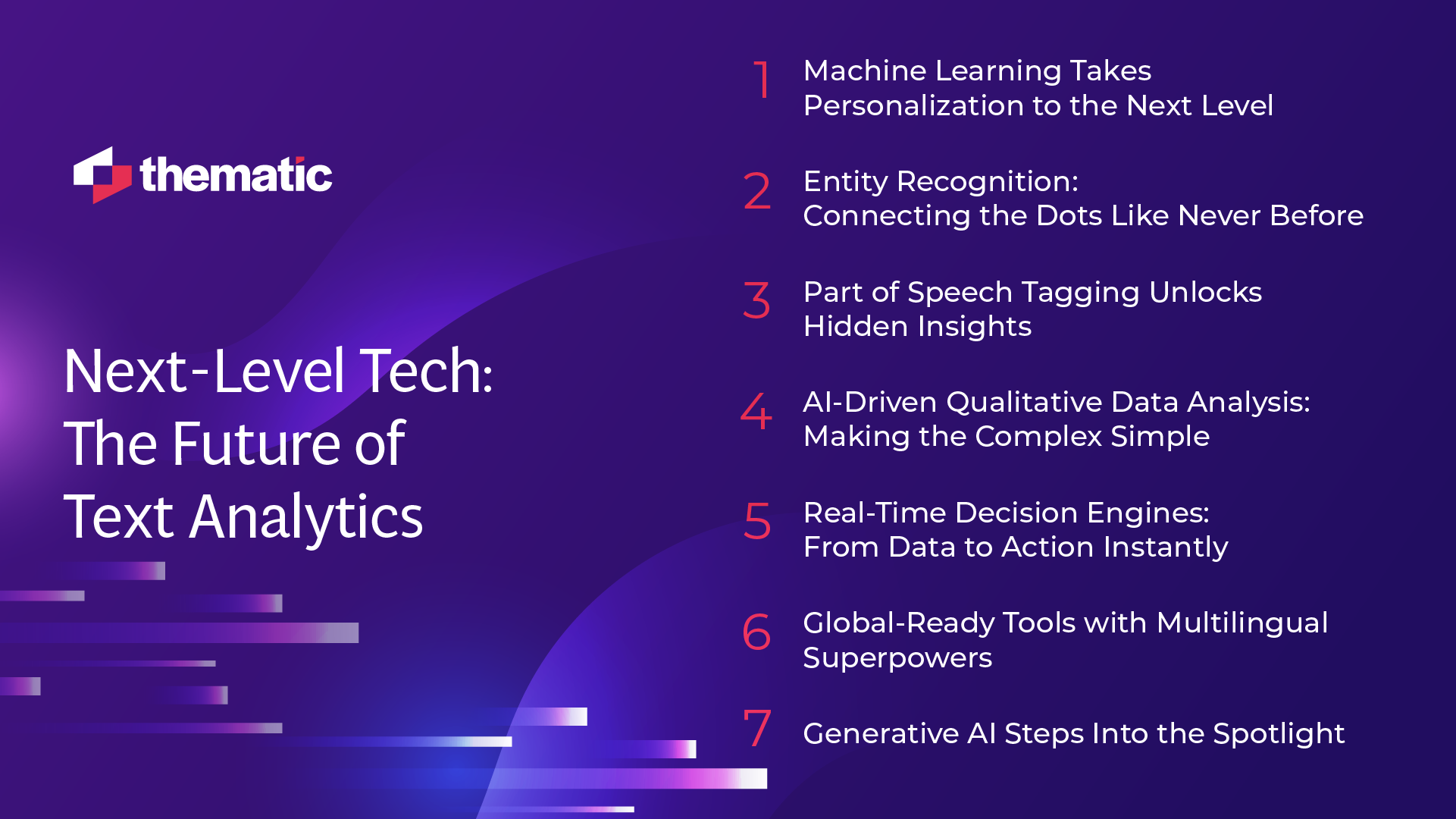
Transforming customer feedback into actionable insights can feel like solving a puzzle with too many pieces—but not with Thematic.
By combining advanced AI with human expertise, Thematic redefines what’s possible in text analytics, turning chaos into clarity and feedback into strategy.
Thematic uses a hybrid AI system that combines two kinds of data:
But it doesn’t stop there. Thematic adds a human touch to refine AI results, ensuring they’re accurate and easy to use.
Here’s an example: During a storm, Watercare had a surge in customer complaints. Thematic analysis software helped them figure out the main issues—delayed repairs and poor communication. Teams across departments used these insights to respond faster and rebuild customer trust.
With Thematic, feedback isn’t just analyzed—it’s transformed into solutions.
Thematic is among the top AI text analysis tools. It’s powerful and practical. Here’s what makes it a standout solution for businesses of all sizes:
Whether you’re managing feedback from 100 or 100,000 people, Thematic scales to meet your needs.
Atlassian, for example, used Thematic to analyze feedback from 250,000 users. Thematic found recurring problems and helped them create a system for continuous product improvement.
Thematic’s dashboards are user-friendly, even for people who aren’t tech experts.
Atom Bank used Thematic to combine feedback from app reviews and customer service logs. This helped them reduce complaints about mortgages by 69% and grow their business.
From small teams to large organizations, Thematic delivers insights that drive results.
Timing matters, especially when dealing with unhappy customers. Thematic provides real-time insights so you can act fast.
For example, Vodafone New Zealand used Thematic to track customer feedback in real time. They found common issues, improved staff training, and made changes to their operations. This improved customer satisfaction and their Net Promoter Score (NPS).
With Thematic, you don’t just react—you stay ahead.
Thematic uses generative AI to save time and focus on what matters most. The AI can:
This means your team spends less time sorting through data and more time improving your products and services.
This video walks you through the newest features of Thematic.
Starting with text analytics might feel like a big task, but it doesn’t have to be. With the right steps, you can turn customer feedback into powerful insights that improve your business. Here’s a simple guide to help you get started.
To make text analytics work for your business, follow these key steps:
It’s important for company leaders to support your text analytics efforts. Clear goals help everyone understand what you want to achieve.
For example, companies with a Chief Data Officer (CDO) often create better plans for using data. By 2024, 60% of businesses with strong leadership in this area will have detailed data strategies.
Not all tools are the same. Pick one that is easy to use, fits your workflow, and can grow with your business. Tools like Thematic make it simple to integrate feedback analysis directly into your daily operations. Learn more about choosing tools for product validation.
To see results, text analytics must be part of your regular processes. For example, integrating Thematic allows teams to track feedback continuously and adapt strategies as needed.
Using data from different places, like surveys, reviews, and social media, gives you more accurate insights. If you work in global markets, consider regional differences. For instance, North America leads in adopting analytics, but Asia Pacific and Europe are catching up.
Predictive models help categorize customer feedback into groups like “happy” or “unhappy.” But, as customer behavior changes, you need to monitor and update these models regularly to keep them accurate.
When you start using text analytics, it’s not just about the technology. You also need to think about how to use it responsibly.
By focusing on these principles, you can make sure your text analytics efforts are effective and ethical.
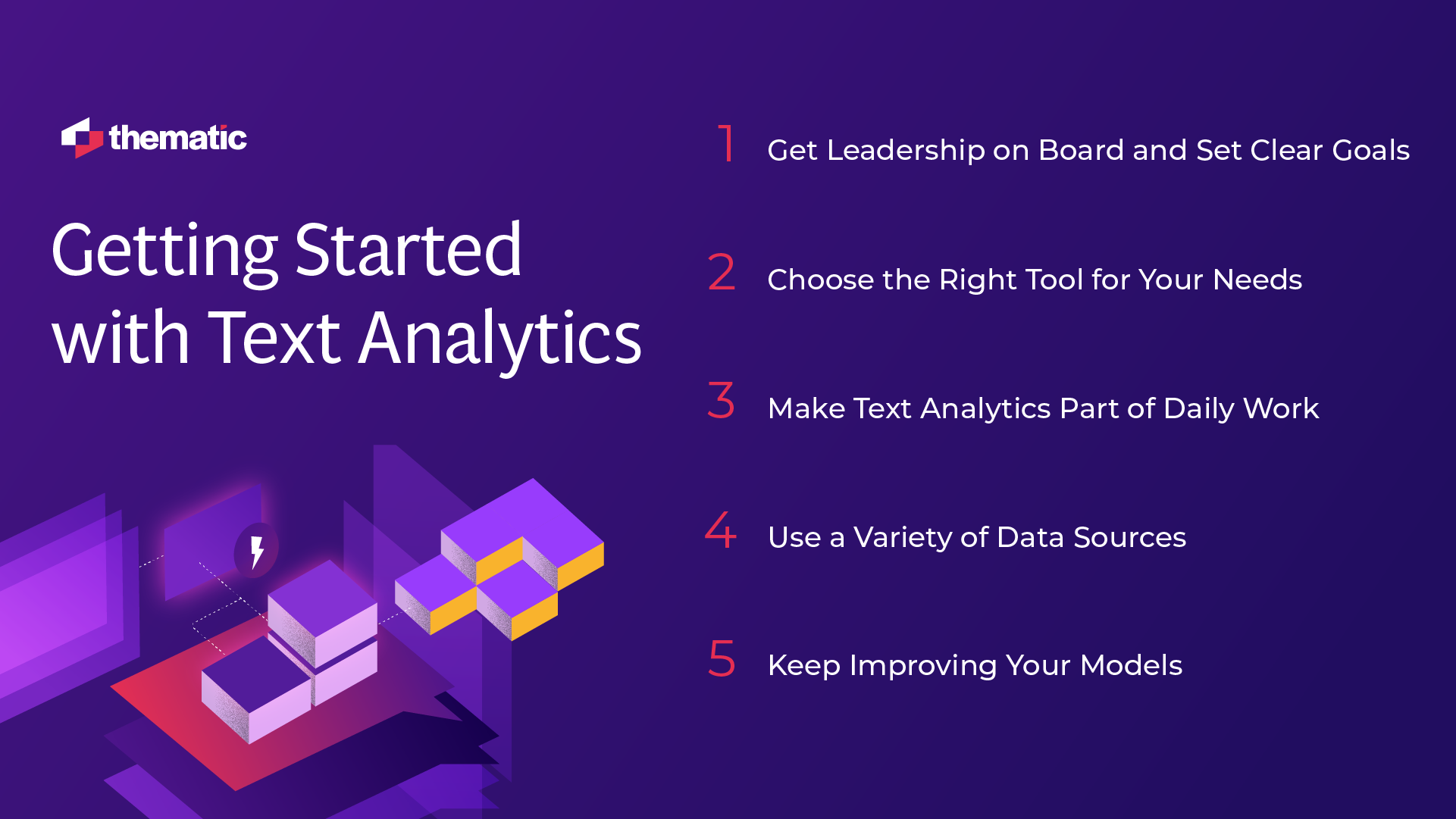
Here are some simple tips to make your transition to text analytics smooth:
By following these steps, you’ll be able to use text analytics to make better decisions and improve your business.
Customer feedback holds the answers to your biggest business questions—but only if you know how to find them. That’s where text analytics comes in. By turning unstructured data into clear, useful insights, you uncover trends, solve problems, and keep your customers happy.
Look at how businesses like Watercare, Atlassian, Atom Bank, and Vodafone transformed their feedback into results with Thematic. They solved real problems, improved workflows, and gained a competitive edge—all by tapping into the power of text analytics.
So, what could text analytics do for you? Whether you’re looking to enhance customer experience, create smarter products, or make better decisions, this tool can take your business to the next level.
Ready to get started? Try Thematic now!
Join the newsletter to receive the latest updates in your inbox.